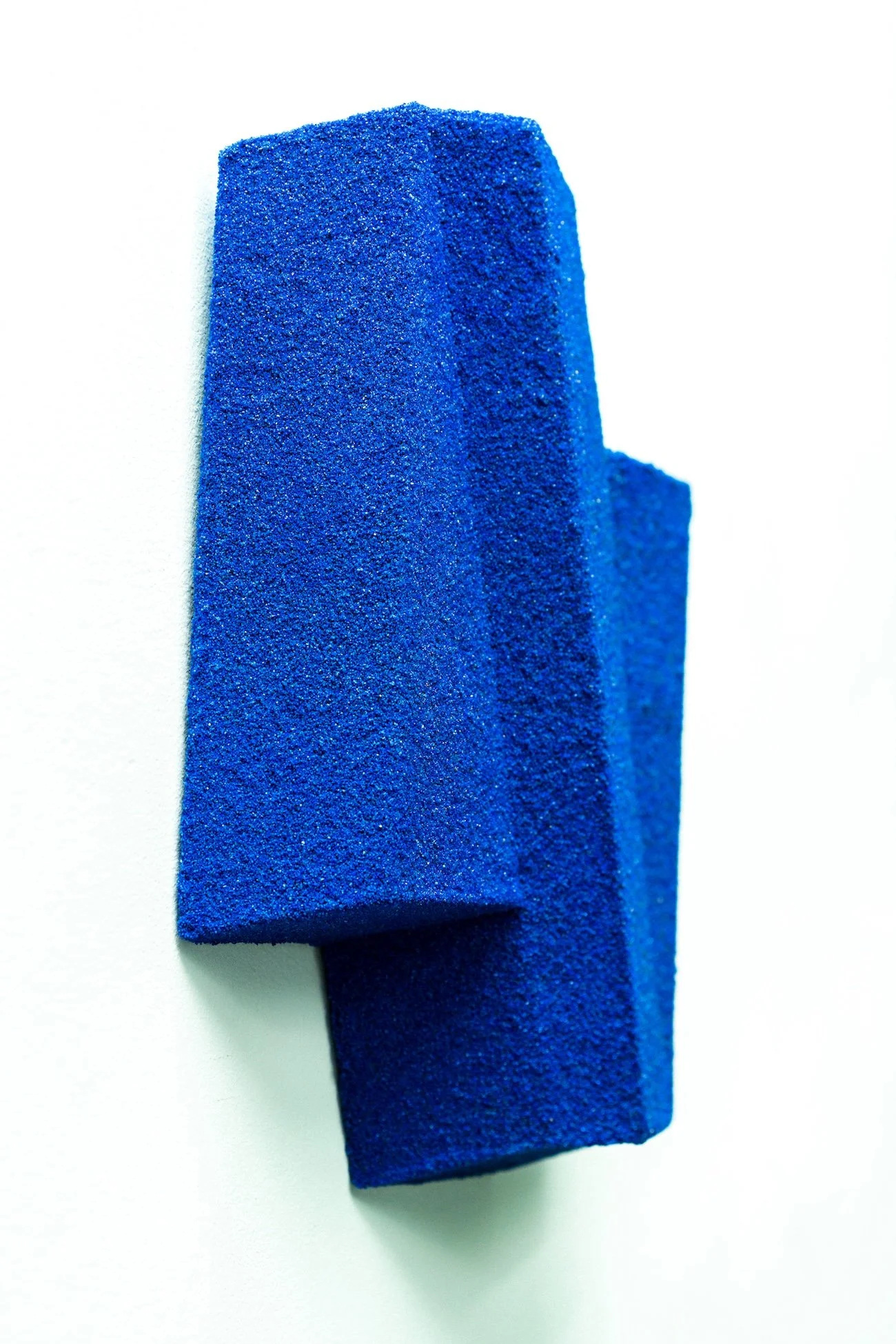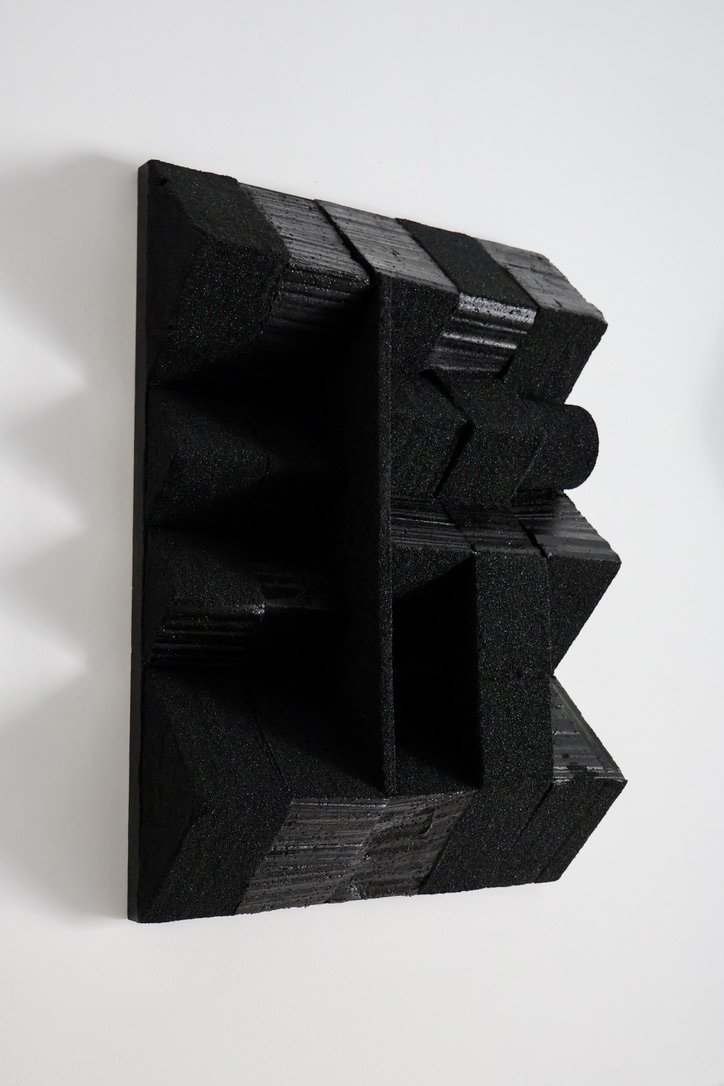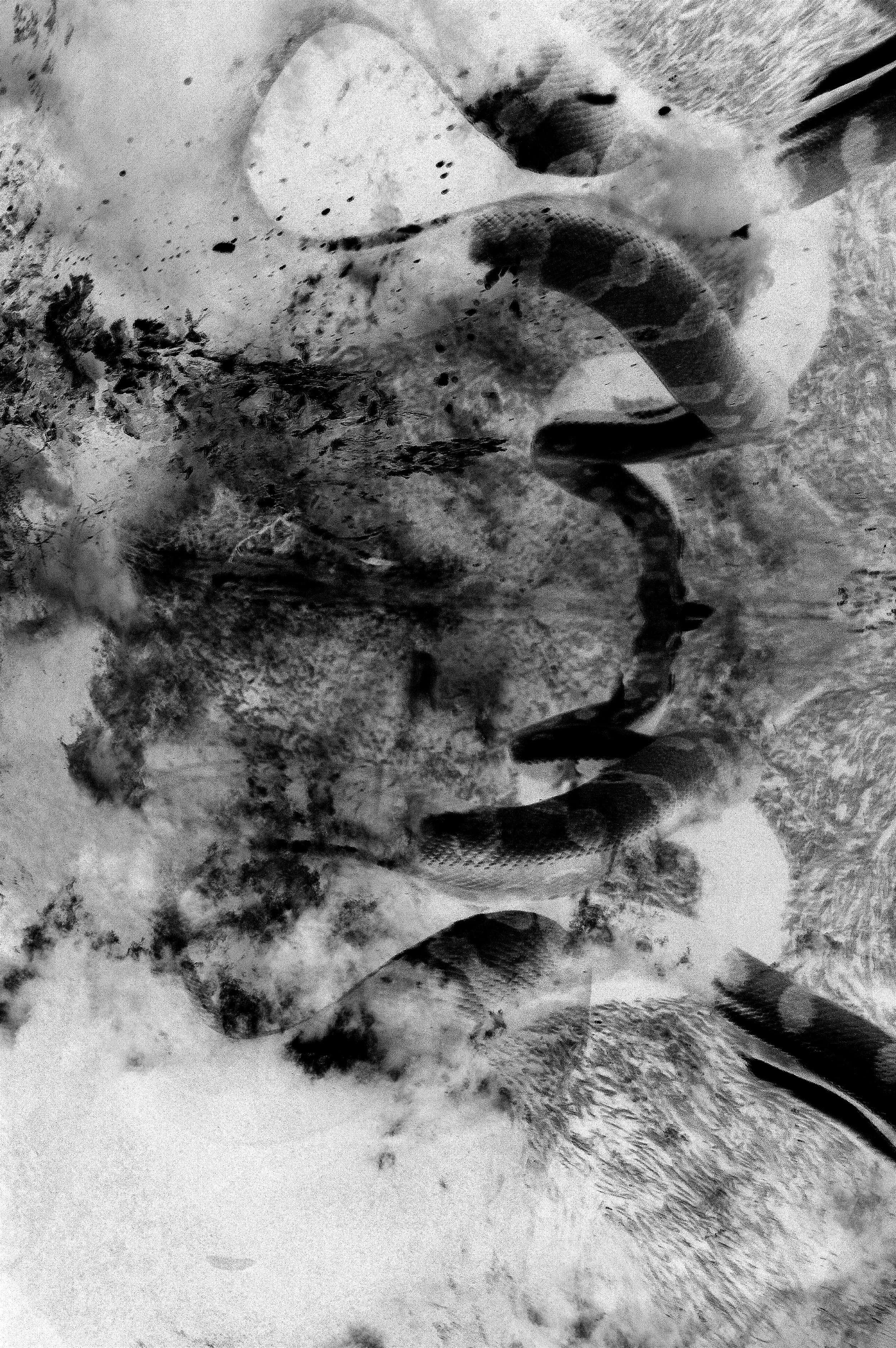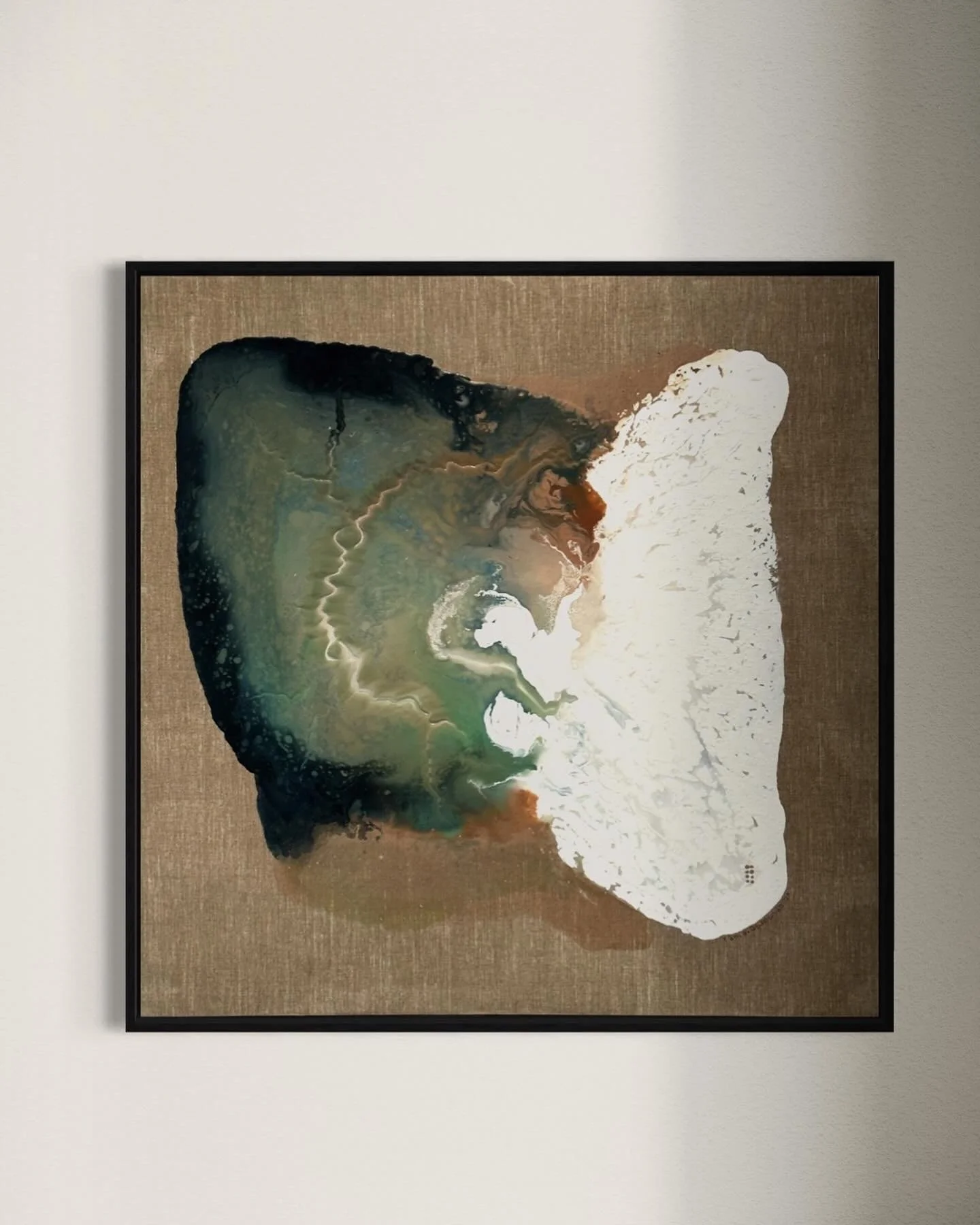Interview with Elena Shuppo
Artist Statement
My practice is a manifestation of intricate thoughts expressed through simple geometric forms. My wall sculptures are characterized by sharp edges, monochromatic hues, and vibrant colours achieved through the use of powder pigment. I blur the lines between architecture and art, bringing exterior into the interior. I exploring the duality of matter and spirit, lightness and darkness, visible and invisible, conscious and unconscious, as well as of personal boundaries, including physical, emotional, and mental facets. In my practice I encourage the audience to reflect on their perception of diversity in society. I argue that individuals should strive to embrace it and recognise the value it brings to a harmony of society, making the ‘other’ an essential part of ‘us’.
The approach involves rescaling architecture and bringing selected aspects into a smaller environment, creating a seamless blend between architecture, art, and human nature. Deconstructing of architectural plans, dissociating of certain fragments, rescaling them, and reproducing in 3D bring possibility to fit into proportionally smaller spaces, such as private interiors or public space.
In my sculptures I reveal my sensitivity to texture, light, form, and color, expressed in an abstract minimalistic language. While conceptually, my works refer to personal boundaries in socio-political context.
My hand-constructed objects operate parallel to the external form as a personal space and physical touch, while the emptiness inside constructions refers to emotional and mental boundaries, identity, and self-sense. My recent work delves into the uneasy continuum of dualism of boundaries, exploring the balance between setting healthy boundaries and remaining willingness to new experiences and perspectives.
SHELTER’22
As an immigrant, my personal journey has been one of displacement, re-interpretation, and reconciliation – themes that are present within the ‘Shelter ‘22’ project. My current project is a reflection of my journey as a multiple-time immigrant, seeking to understand the complex emotions that have shaped my entire life. Each sculptural piece is a testament to the concept of home and its evolution through navigating diverse geographical and cultural environment. I am constructing representations of homes I have lived, where I currently reside, where I may dwell, and where I shall never depart. They are akin to sandcastles deep inside me that shall never be washed away by the tides of time. When the temporal becomes eternal, the surreal becomes tangible, and moments stretch into decades.
I firmly believe that home resides within me. It allows me to feel grounded and secure, even in unfamiliar surroundings. It gives me the courage to explore new places and take on new challenges, knowing that I always have a safe haven to return to. This belief empowers me to be resilient and adaptable, embracing change and uncertainty with confidence, and to feel my personal boundaries in the present moment.
My body represents the structure, akin to a house, that holds my memories and traditions of my homeland and new culture experiences of my newly adopted country. This edifice, once hollow, is now brimming with the richness of my past and my present. Through my art I delve into complexities of migration unearthing the memories, traumas, fears, and anxieties that accompany such a journey. I open up a conversation through my work with my audience urging viewers to acknowledge their own sense of home and belonging. I encourage the audience to reflect on their perception of diversity. Is is simply a stark contrast that generates a feeling of isolation or a delightful assortment that contributes to a harmony of society, making the ‘other’ an essential part of ‘us’?
You pursued a degree in Economics before venturing into the world of art and design. What were your early artistic influences, and what inspired the shift from economics to pursuing art and design?
I've been passionate about drawing since my early years, sketching wherever and whenever I could. At the age of six, I even attempted to enroll myself in an art school, but was turned away, likely due to my lack of parental accompaniment. This rejection was a significant blow, causing a shift in my life's trajectory. I found myself attending music school and eventually earning a degree in Economics, despite my dreams of becoming an architect. However, I am who I am today because of this journey and I am happy with that. I believe this is a common narrative among creative people who, at some point, may have veered off their intended path. My dream and the invaluable experience I gained while working at Chanel guided me. Eventually, I reached a point where I could no longer ignore my calling, leading me to enroll in design school.
Working in the fashion house CHANEL must have been an enriching experience. How did your time there influence your approach to art and design?
Indeed, those eight years profoundly transformed me and my visual perception. I was exposed to extraordinary aesthetics, creativity, and the fusion of various crafts, all converging to create a single, magnificent product. This internal striving for perfection, coupled with the desire to keep up with the times, was truly inspiring. Gabrielle Chanel was an innovator of her era, embodying audacious ideas and decisions that were far ahead of her time. Practically speaking, I always adhere to Gabrielle Chanel's rule: "the reverse side of a product should be as flawless as the front." Along with this, my color perception was shaped during this period: I have a fondness for monochrome and bold colours, which I incorporate into my work. To me, this is far from monotonous; the volume of my sculptures is revealed in color.
You've studied at the “Details” design school and Chelsea College of Art, among other places. How have these diverse educational experiences shaped your artistic philosophy and style?
I wouldn't say that it's a completely different experience. One complemented the other, for me it's quite a logical interconnection. My studies at the design school not only gave me a new profession, but rather pushed me towards forming an understanding of what really is my passion and purpose, if you will. Interior design incredibly develops visual perception, a sense of style, form, color, and light. It especially helps with spatial perception. I am very close to the idea of In-Ex, which is often used in interior design: the complementarity of the exterior and interior. I slightly transformed this idea in my practice: I defragment architectural plans or GPS maps, scale these parts and give the scheme volume using 3D modeling. At the moment, this is manual work in a classic architectural technique. I am an absolute adept of sculpture and 3D art.
You've realized several projects in private interiors. How does designing for private spaces differ from creating public art installations or exhibits? Do you approach them differently?
Well, comissions impose certain limitations on me as an artist: I create an artwork for a very specific space and individual. Even when the client allows me "freedom", I focus on the space and his personal preferences, my interior designer input is considered, but tit only accounts for about 20-30 percent. The remaining 70 percent is pure creativity, which I am quite content with. My sculptures aren’t suitable for every interior in terms of style. Typically, the client comprehends how seamlessly my reliefs blend in: after all, lan appreciation for minimal art coexists with a person’s distinct taste and personality.
Participating in exhibitions also sets its own parameters, such as the curatorial concept in the case of a group exhibition, and the general statement, the compatibility and harmony of works by different artists... The atmosphere of pure creativity reigns exclusively in the artist's studio, I think.
Can you tell us about the first artwork you created specifically for an interior design project? What was the concept behind it, and how did it complement the space?
The very first piece was crafted for our family home, a minimalist haven with pristine white walls that we had constructed. My spouse and I have divergent tastes and perspectives on art, leading to a year-long search for a piece that would appeal to both of us. During this period, we were engrossed in meditation and works of Joe Dispenza, who proposed that no particle manifests in reality until it garners our attention. This concept became the foundation for the artwork: I aimed to create a piece that wouldn't demand immediate attention, but upon closer inspection, would reveal itself as a unique art object. The challenge was akin to accentuating something white against a white backdrop. It became clear that this could be accomplished through the use of dimension and the interplay of light and shadow. Consequently, the first constructivist-style piece was born. To my delight, my husband was quite taken with it (a rare occurrence), which further fueled my inspiration. Within a matter of weeks, I had set up a studio and sourced suppliers. I firmly believe that an artist's creations should adorn the walls of their own home: art should permeate the living space, infusing it with warmth and profound meanings.
Since moving to Spain, you’ve started incorporating bright colors and sea sand into your work. What inspired this shift, and how do these elements reflect in your series of Spheres and Constructivism?
Relocating to Spain was akin to the transition from black and white to color cinema in my life. I had never before experienced such a vibrant palette: the perpetually blue sky, the evergreen forests of Costa Brava, the azure sea, and the breathtaking beauty of vivid sunsets. It was an astonishing blend for someone who had grown up and resided in a forever grey city. Even now, I am continually amazed by the proximity of nature, which evokes a sense of childlike wonder daily! Naturally, in such a setting, the use of color was inevitable: hues of green, blue, red, and yellow emerged. However, I remained faithful to my preference for primary, saturated colors, abandoning any half-tones.
Could you describe your artistic process? How do you approach the construction of space, volume, color, and light in your work?
I aspire for my art to embody power and resilience, with the inherent strength of pure geometric shapes. The concept of sand also plays a significant role, with numerous grains uniting to form a cohesive entity. Its coarse texture evokes a sense of solidity and durability.
My approach involves rescaling architecture and bringing selected aspects into a smaller environment, creating a seamless blend between architecture, art, and human nature. Deconstructing of architectural plans, dissociating of certain fragments, rescaling them, and reproducing in 3D bring possibility to fit into proportionally smaller spaces, such as private interiors or public space.
In my sculptures I reveal my sensitivity to texture, light, form, and color, expressed in an abstract minimalistic language. While conceptually, my works refer to personal boundaries in socio-political context.
My hand-constructed objects operate parallel to the external form as a personal space and physical touch, while the emptiness inside constructions refers to emotional and mental boundaries, identity, and self-sense.
The gaps that distinguish and define the original “components” of the entire object are significant. I aim to perceive the entire object before acknowledging its individual parts: I want the observers to understand the composition of the piece and question its solidity.
I find pleasure in juxtaposing the old with the new, materials with contrasting qualities. I am comfortable exploring this domain and appreciate the aesthetic contrast it introduces. The sharp, pristine lines of the man-made contrast beautifully with the soft, tactile nature of the sand. The added satisfaction of repurposing polystyrene, which is typically discarded and seldom recycled, is also important.
Natural materials like sand serve to link and ground the price to the earth. Industrial man-made materials such as cardboard, EPS plastic, or polystyrene possess a more anonymous aesthetic, yet they excel in terms of shape and weight ratio. Weight is particularly crucial as I specialize in wall sculptures. A simplified palette and vocabulary align with my desire for my forms to communicate.
What have been some of the biggest challenges you’ve faced in your artistic career, and what do you consider your most rewarding achievement so far?
As a multiple -time immigrant, I've had to rebuild my life from the ground up three times in three years. The art markets in Russia, Spain, and the UK are vastly different from one another. Starting both personal and professional life from scratch , knocking on every door, is incredibly challenging. But as they say, what doesn't kill us makes us stronger. It's crucial to have faith in yourself, your family, your talent, set goals, and strive towards them! In a few months, I'll be participating in an exhibition in Paris! It was my dream to return to this city, which holds so much significance for me, in a new and authentic - as an artist. My advice to all creatives in emigration - don't stop! Work, promote yourself, showcase your work, and keep moving forward!
As a renowned artist whose work has gained significant recognition and influence, how do you balance staying true to your personal artistic vision with the evolving trends and expectations of the contemporary art world?
As an experienced immigrant, I've come to understand a crucial truth: it's vital to remain authentic and establish firm boundaries with the external world, to prevent losing oneself unnoticed. When you scrutinize the world and yourself critically, this is less likely to occur. Moreover, it's essential to continue your personal and professional growth, always bearing in mind the significant questions: "What am I doing? Why am I doing this?". An artist must possess a unique identity and stay faithful to his ideas. These ideas can, and perhaps should, evolve over time. I observe the world's transformations and extract what I need: my art should primarily satisfy me.
Looking ahead, are there any new themes or techniques you are eager to explore in your future projects? What can your followers and art enthusiasts expect from you in the coming year?
For me, the journey of discovering new techniques is an ongoing one. Typically, I do not prefer to showcase materials in a direct and transparent way: cardboard and plastic are often coated with 4-5 layers of tinted sand. I am keen to experiment with materials that don't need to be concealed: steel and natural stone possess their own inherent aesthetics, but they add considerable weight to the sculpture. So, I'm excited to experiment with these elements in the future. I'm contemplating the fusion of materials with contrasting values to accentuate the form.



















